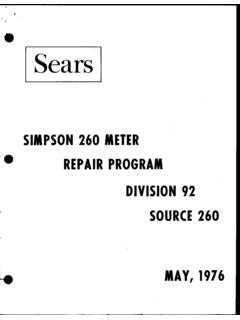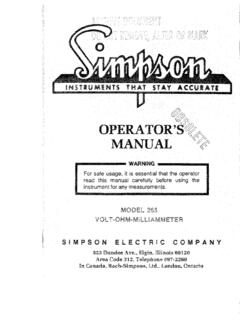Transcription of IEEE 2030.5™-2013 (Smart Energy Profile 2.0) - …
1 An Overview for KSGA IEEE -2013 (Smart Energy Profile ) Robby Simpson, PhD System Architect, GE Digital Energy April 24, 2015 Agenda 2 Time Program Activity 10:00~10:30 Registration KSGA 10:30~12:00 IEEE : Motivation, Example Applications Bill Ash Robby Simpson, PhD 12:00~13:30 Lunch 13:30~14:30 IEEE : Relationship to other Smart Grid Standards, Testing and Certification Bill Ash Robby Simpson, PhD 14:30~14:50 Break 14:50~16:50 IEEE : Technical Overview Bill Ash Robby Simpson, PhD 16:50~17:00 Conclusion IEEE : Motivation, Example Applications 3 Image from xkcd ( ), licensed under a Creative Commons Attribution-NonCommercial License Smart Grid Home Area Network (HAN) An addition to existing consumer HANs The integration of consumer devices into the smart grid Serves two general purposes.
2 Inform the consumer ( , Energy usage, pricing) Request actions to assist the grid ( , thermostat changes, plug-in electric vehicle charging) Focus on communications related to efficiency, usage, price, demand response and load control, and service provider messages One or more Energy Services Interfaces (ESI) serve as the gateway the utility / service provider voice into the home Often, but not always, a smart meter 4 An Analogy Example Devices for the Smart Grid HAN Smartphone Tablet Television Computer Thermostat Smart Meter Pool Pump Water Heater Smart Appliance 6 Cloud Server Plug-in Electric Vehicle Solar Inverter Energy Management System Building Management System Background / History of IEEE (SEP 2) Evolution of ZigBee Smart Energy A widely deployed standard for the Smart Grid HAN Provides most, if not all, of the needing application information (more on that in a moment)
3 Robust testing and certification program with a certification mark 60+ million meters currently deployed or under contract, from a variety of manufacturers ~550 Certified Products However, limited to the ZigBee PRO technology ( at GHz running the ZigBee PRO stack) 7 Motivations for a New Version: Multiple Link Layers Link layer (MAC/PHYs) technologies have different strengths and weaknesses ( , Wi-Fi, HomePlug, Ethernet) Internetworking! Consumers may already have various link layer technologies Smartphone with Wi-Fi and/or Bluetooth TV with Ethernet and/or Wi-Fi Desire to enable multi-dwelling units (MDUs) and other scenarios where a single wireless technology may not be feasible 8 Motivations for a New Version: Widely-Adopted Technologies Encourage a vast ecosystem Allow consumers to use existing devices Rapid development and adoption enable guy in a garage Use commercial off-the-shelf products, existing software libraries, etc.
4 Vast labor pool Wisdom of large community Long-life / Forwards compatibility Already mature Intellectual property better understood 9 Motivations for a New Version: A True Profile Options and configurations selected for interoperability Standards Selecting instead of Standards Defining Nothing new a collection of widely-adopted standards All pieces of IEEE sourced from standards developing organizations (SDOs) 10 Motivations for a New Version: Range of Backhaul Technologies Not all consumers have broadband Internet access Not all consumers have Advanced Metering Infrastructure (AMI) Some jurisdictions require capability when consumer has no Internet access Range of bandwidths: Broadband Internet: 10s of Mbps Cellular AMI: 100s of Kbps Mesh AMI: 10s of Kbps And some PLC AMI are < 1 bps!
5 Desire to enable all, while taking advantage of higher bandwidths where possible 11 Motivations for a New Version: Range of Device Constraints Embedded devices often have limited hardware resources 10s of KB of RAM 100s of KB of Flash See RFC 7228 Smart Grid HAN devices often have strict Energy constraints Gas and water meter may need a single battery to last 10-20 years! Many thermostats are battery-powered 12 Motivations for a New Version: Secure! Security and privacy concerns paramount Cybersecurity attacks on smart grid can have significant consequences in the physical world Smart Grid HAN one piece of consumer s network Cannot be weak link Rest of consumer network may be insecure Little to no physical protection Devices need to last decades Many governments have cybersecurity guidelines and requirements 13 And New Partners!
6 +Key Technology Decisions Internet Protocol (IP) RESTful HTTP TLS (HTTPS) IEC 61968 (CIM) More on protocols in the Technical 15 Why IP? Internetworking mixing various link layer technologies Use routers instead of application layer gateways No knowledge of Smart Energy required in the router Allows for end-to-end security Easily connect consumers existing devices Eases convergence and architecture changes As an example, allows smart phone, using Wi-Fi, to speak directly and seamlessly to electricity meter, using ZigBee, as well as a plug-in electric vehicle, using HomePlug 16 Why HTTP? The web protocol we all know and love Long life, particularly when compared to alternatives reduced risk of stranded assets Familiar to consumers and developers larger ecosystem Eases ability to also provide web pages code reuse 17 Why TLS (HTTPS)?
7 Same security used and proven in Internet banking Desire to meet US NIST requirements (Suite B) Facilitate end-to-end security 18 Why IEC 61968 (CIM)? Smart Grid dictionary Reuse of knowledge of smart grid industry Same data used in home as used in utility backoffice and smart meter networks less risk of translation errors 19 A Variety of Architectures In-home only Via smart meter Via Internet Cloud-based ESI Combinations of the above The use of IP eases convergence and architecture changes 20 High-Level Design Divided into Function Sets independent sets of functionality Any device can be a server and/or a client for a function set servers provide the data, clients use the data Can have multiple servers for a function set allows for multiple service providers If desired.
8 Clients can be assigned to servers Not restricted to Energy supports multiple commodities (water, natural gas, steam, etc.) 21 Some IEEE Functionality Price Communication Demand Response and Load Control Energy Usage Information ( , meter data) Service Provider Messaging Prepayment Metering Distributed Energy Resources Electric Vehicle Billing Communication File Download / Update 22 Price Communication Information only Support for many types of tariffs Time-based Consumption-based Combinations Bi-directional support (feed-in tariffs) Can even communicate alternative costs such as carbon emissions or percentage of Energy generated cleanly 23 Price Communication (continued) Example clients.
9 Could be as simple as a device that displays current price (TV, for example) Or devices can act on the price: Refrigerator can shift defrost cycle to optimal time HVACs can pre-cool and pre-heat homes Plug-in electric vehicles can select optimal time to charge Clothes dryers can use lower heat setting Solar panels can intelligently feed back to grid Many others Example servers: Smart Meter Standalone ESI Cloud-based ESI 24 Demand Response and Load Control Typically provided as utility / service provider programs Events can be high-level: Request to shed a certain amount of Watts Events can be more detailed (load control): Thermostat setpoints or offsets Duty cycle May address specific devices and device types ( , water heater) Allows devices to shed load or simply shift load Devices may advertise their ability to shed Devices may respond with details regarding their actions 25 Demand Response and Load Control (continued) Example clients: Could be as simple as a device that displays the requested event Or devices that act on the event: Thermostat Pool pump Smart appliance Water heater Electric vehicle Many others Example servers.
10 Smart meter Standalone ESI Cloud-based ESI 26 Energy Usage Information Variety of measurements (more on that during Technical Overview) Variety of commodities ( , electricity, natural gas, water) Near real-time Unlimited number of usage points Mirroring capability for sleepy devices such as gas meters Bidirectional 27 Energy Usage Information (continued) Example clients: A device that displays usage data A device that stores usage data for historical analysis A device that alerts or makes suggestions based on usage data Example servers: Smart electricity meter Smart gas meter Cloud-based server Smart appliance with metering capability Any device capable of measuring usage!







